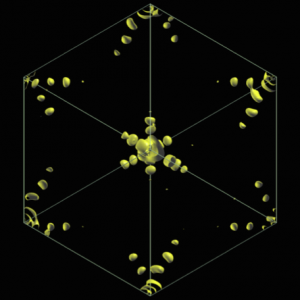Fabiano Corsetti and Arash Mostofi, Negative-U properties for substitutional Au in Si, Europhysics Letters 105, 57006 (2014) [ONLINE JOURNAL|PDF]
It’s well-known that atomic defects are crucial for the operation of semiconductor devices. Not all defects, however, are desirable. Gold dopants in silicon, for example, introduce electronic levels that sit deep within the band gap of silicon, acting as electron traps, leading to a large decrease in conductivity. Understanding the properties of gold in silicon has also received recent interest due to the use of gold as a catalyst in the growth of semiconducting nanowires in a process that can result in the presence of gold impurities in significant excess of the solubility limit that would be expected in bulk silicon.
Fabiano has addressed a long-standing puzzle in the properties of the gold substitutional defect in silicon, namely that there is no electron-paramagnetic resonance (EPR) signal associated with it. This is particularly puzzling since the isoelectronic Pt1- impurity in silicon does show a strong EPR signal. Why, then, does gold, which is adjacent to platinum in the periodic table, behave so differently? This question was first posed by F.G. Anderson [J. Phys.: Condens. Matter 3, 4421 (1991)] and has since remained without a definitive answer.
His state-of-the-art first-principles calculations suggest that the reason for the lack of an EPR signal for Au in Si is that this defect is what is known as a “negative-U” center, i.e., the system is thermodynamically stable only when the electronic states associated with the defect are doubly occupied. It is this suppression of unpaired spins associated with the defect that results in the lack of an EPR signal in experiments. The robustness of his results is supported by the quantitative agreement, within chemical accuracy, between the experimentally measured defect level transitions and his calculated predictions.
This work was part of Fabiano Corsetti’s PhD.
